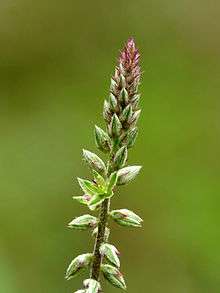Achyranthes aspera
| Achyranthes aspera | |
|---|---|
 | |
| Scientific classification | |
| Kingdom: | Plantae |
| (unranked): | Angiosperms |
| (unranked): | Eudicots |
| (unranked): | Core eudicots |
| Order: | Caryophyllales |
| Family: | Amaranthaceae |
| Genus: | Achyranthes |
| Species: | A. aspera |
| Binomial name | |
| Achyranthes aspera L. | |
Achyranthes aspera (common names: chaff-flower,[1] prickly chaff flower,[2] devil's horsewhip,[3] Sanskrit: अपामार्ग apamarga) is a species of plant in the Amaranthaceae family. It is distributed throughout the tropical world.[4] It can be found in many places growing as an introduced species and a common weed.[5] It is an invasive species in some areas, including many Pacific Islands environments.[6]
It is one of the 21 leaves used in the Ganesh Patra Pooja done regularly on Ganesh Chaturthi day. In Uttar Pradesh the plant is used for a great many medicinal purposes, especially in obstetrics and gynecology, including abortion, induction of labor, and cessation of postpartum bleeding.[7] The Maasai people of Kenya use the plant medicinally to ease the symptoms of malaria.[8]
Chemical constituents
Achyranthes aspera contains triterpenoid saponins which possess oleanolic acid as the aglycone. Ecdysterone, an insect moulting hormone, and long chain alcohols are also found in Achyranthes aspera.[9] Medicinally important chemicals like achyranthine, betaine, pentatriaontane, 6-pentatriacontanone, hexatriacontane and tritriacontane are also present.[10]
Traditional medicine
Achyranthes aspera has occupied a pivotal position in Indian culture and folk medicine. Since ancient times the tribal and rural people of India commonly use this herb in various disorders. Achyranthes aspera is known for its mood enhancing effects and is used to treat depression and forms of anxiety.
Other uses
The juice of this plant is a potent ingredent for a mixture of wall plaster, according to the Samarāṅgaṇa Sūtradhāra, which is a Sanskrit treatise dealing with Śilpaśāstra (Hindu science of art and construction).[11]
Names
Achyranthes aspera has different names in various languages:[12][13]
- Sanskrit: Adhoghanta, Adhvashalya, Aghamargava, Aghata, Apamarga, Apangaka, Chamatkara, Dhamargava
- Hindi: Apang, Chirchra, Chirehitta,Latjira, Onga
- Assam: Apang
- Bengali: Apang
- Gujarati: Safed aghedo, Anghadi, Andhedi, Agheda
- Kannada: Uttaranee
- Malayalam: Kadaladi, Katalati
- Marathi: Aghada, Aghara, Pandhara-aghada
- Persian: Kharevazhun
- Punjabi: Kutri
- Tamil: Nayurivi, Shiru-kadaladi
- Telugu: Antisha, Apamargamu, Uttareni
- Sinhalese: Gaskaralheba, Karal seba
- Indonesia: Jarong
- Arabian: Atkumah
- French: Achyranth a feuilles rudes, collant, gendarme
- Spanish: Mosotillo, rabo de gato, rabo de chango, rabo de raton
- Afrikaans: Grootklits, langklitskafblom
- Tocharian B: apamārga, viśīr[14]
- Vietnamese: Cây cỏ xước
- Somali: sariibiye
| Wikimedia Commons has media related to Achyranthes aspera. |
References
- ↑ "BSBI List 2007" (xls). Botanical Society of Britain and Ireland. Archived from the original on 2015-02-25. Retrieved 2014-10-17.
- ↑ Flowers of India
- ↑ USDA Plants Profile
- ↑ Flora of North America
- ↑ GRIN Species Profile
- ↑ Pacific Islands Ecosystems at Risk
- ↑ Khan, A. V. and A. A. Khan. Ethnomedicinal uses of Achyranthes aspera L. (Amaranthaceae) in management of gynaecological disorders in western Uttar Pradesh (India). Archived November 24, 2010, at the Wayback Machine. Ethnoleaflets.
- ↑ Bussmann, R. W., et al. (2006). Plant use of the Maasai of Sekenani Valley, Maasai Mara, Kenya. J Ethnobiol Ethnomed 2 22.
- ↑ Indian Herbal Pharmacopia Vol. II, Page-5.
- ↑ http://www.researchgate.net/profile/Pradeep_Singh8/publication/216410155_Achyranthus_aspere-An_important_medicinal_plant_A_review/links/0c96051cc5185491de000000.pdf
- ↑ Nardi, Isabella (2007). The Theory of Citrasutras in Indian Painting. Routledge. p. 121. ISBN 1134165234.
- ↑ Dr. K. M. Nadkarni's Indian Materia Medica, Volume 1, Edited by A. K. Nadkarni, Popular Prakashan, Bombay, 1976, pp. 21-2.
- ↑ "Archived copy" (PDF). Archived from the original (PDF) on 2014-03-27. Retrieved 2015-09-28.
- ↑ http://dictionaries.brillonline.com/tocharian-b